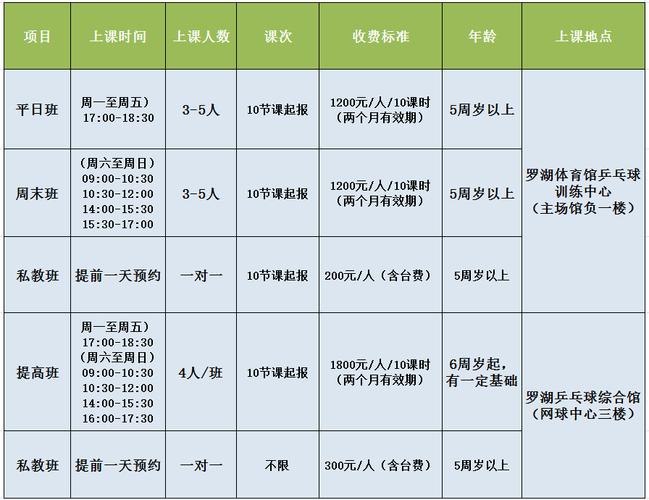领航体育培训学校学费一年多少
999|0条评论
Title: Understanding and Managing Sports Training School Fees
In the realm of sports education, navigating the landscape of training schools and their associated fees is crucial for aspiring athletes and their guardians. Let's delve into the factors influencing fees at sports training schools and how to approach them.
1. Determining Factors for Fees:
Facilities and Equipment:
Schools offering topnotch facilities and stateoftheart equipment often charge higher fees to cover maintenance and upgrade costs.
Expertise of Coaches:
The experience and reputation of coaches significantly impact fees. Renowned coaches command higher fees due to their expertise and track record of producing successful athletes.
Program Duration and Intensity:
Longer and more intensive training programs typically come with higher fees. Programs offering specialized training or personalized attention may also cost more.
Location:
Schools situated in prime locations or areas with high demand may charge higher fees due to increased operating costs or greater perceived value.
Additional Services:
Some schools offer supplementary services like sports psychology sessions, nutrition counseling, or physical therapy, which can influence overall fees.
2. Understanding Fee Structures:
Tuition Fees:
These cover the basic cost of attending the training program and participating in classes, practices, and competitions.
Registration and Administrative Fees:
Onetime charges for enrolling in the school or specific programs. These fees may cover administrative expenses and initial assessments.
Equipment and Uniform Costs:
Some schools include the cost of essential gear and uniforms in their fees, while others require students to purchase these separately.
Travel and Accommodation:
For training camps or competitions held away from the school, additional fees may apply for travel, accommodation, and meals.
Scholarship and Financial Aid:
Schools may offer scholarships or financial aid packages based on merit, need, or athletic potential, which can offset tuition costs.3. Tips for Managing Sports Training School Fees:
Research Extensively:
Explore multiple training schools to compare their offerings, reputation, and fee structures. Consider factors like coaching quality, program content, and alumni success.
Evaluate CostBenefit Ratio:
Assess the value you'll receive in return for the fees charged. A higher fee may be justified if it leads to superior training, coaching, and opportunities for advancement.
Consider LongTerm Goals:
Look beyond immediate costs and consider the potential benefits of investing in comprehensive training programs that align with longterm athletic aspirations.
Communicate with School Administrators:
Don't hesitate to reach out to school representatives to discuss fee details, payment plans, or available financial assistance options. They may be willing to accommodate your needs or provide alternative solutions.
Seek Scholarships and Grants:
Investigate scholarship opportunities, grants, or sponsorship programs offered by the school, sports organizations, or external foundations. These can significantly alleviate financial burdens.
Plan Financially:
Create a budget and financial plan to manage training school expenses effectively. Factor in not only tuition fees but also other associated costs like travel, equipment, and accommodation.
Explore Alternatives:
If the fees of a particular school are prohibitive, explore alternative training options such as community programs, local clubs, or online resources that offer quality training at a lower cost.By understanding the determinants of sports training school fees, grasping fee structures, and implementing strategic approaches to manage costs, athletes and their supporters can make informed decisions that align with their goals and financial capabilities. Investing in quality sports education is an investment in future success on the field and beyond.
体育资讯
MORE>- 搜索
- 最近发表
-
- 演员张丰毅,我这辈子最正确决定,就是和前妻吕丽萍各奔东西
- 中国举重队满额出征世锦赛
- 亚冠情报:中央海岸队史9战日本球队7次落败,横滨远征澳大利亚飞行10小时
- 聚合智慧 | 升华财富 产业智库服务平台
- 体育课“天天见”,要开足更要开好
- 四川:大课间活动评比释放学校体育发展活力
- 中央广播电视总台蛇年春晚吉祥物国产最新地址24小时失效“巳升升”亮相
- 2024中国体育文化博览会、中国体育旅游博览会在苏州举办
- 混合团体世界杯国乒轻取德国队
- 对标世界级赛事场馆,济南黄河体育中心以何担当?
- 体育是读懂中国的一个好窗口
- 跨省也能给家人用 快来学习“医保《c到怀孕为止》动漫钱包”如何操作
- 体育课“天天见”,要开足更要开好
- 多国专家与一线71049.соm查询王中王人道工作者共论“中国人道传统与国际人道理念”
- 什么是外场手?它与体育产业有何关联?
- 勇士队
- 培养高素质体育人才,推动乡村振兴
- 深圳,体育赛事大爆发!
- 体育教育专家吴键谈体育 家长应“放手” 社会要多支持
- 2024中国体育文化博览会、中国体育旅游博览会在苏州举办
- 标签列表
-
- 2024欧洲杯百度百科 (15)
- 2024年欧洲杯足球场 (13)
- 2024欧洲杯比赛时间 (28)
- 为什么欧洲杯看不了 (11)
- 欧洲杯一共多少球队 (15)
- 欧洲杯在哪个国家举行2024 (12)
- 欧洲杯多少支球队参加 (11)
- 欧洲杯为什么没有中国 (14)
- 欧洲杯共多少场比赛 (10)
- 欧洲杯为什么没有直播 (12)
- 欧洲杯有多少只球队参加 (11)
- 2024年欧洲杯预选赛 (14)
- 欧洲杯2024在哪个国家 (11)
- 在哪里可以看欧洲杯预选赛 (13)
- 欧洲杯每场比赛场地 (13)
- 欧洲杯预选赛最新战况 (13)
- 欧洲杯 (16)
- 2024欧洲杯全部赛程 (12)
- 欧洲杯赛程 (11)
- 直播带货公司 (11)
- 直播网站 (12)
- 直播:百度世界2023 (11)
- 直播吧 (20)
- 直播软件 (13)
- 直播代运营公司 (13)



